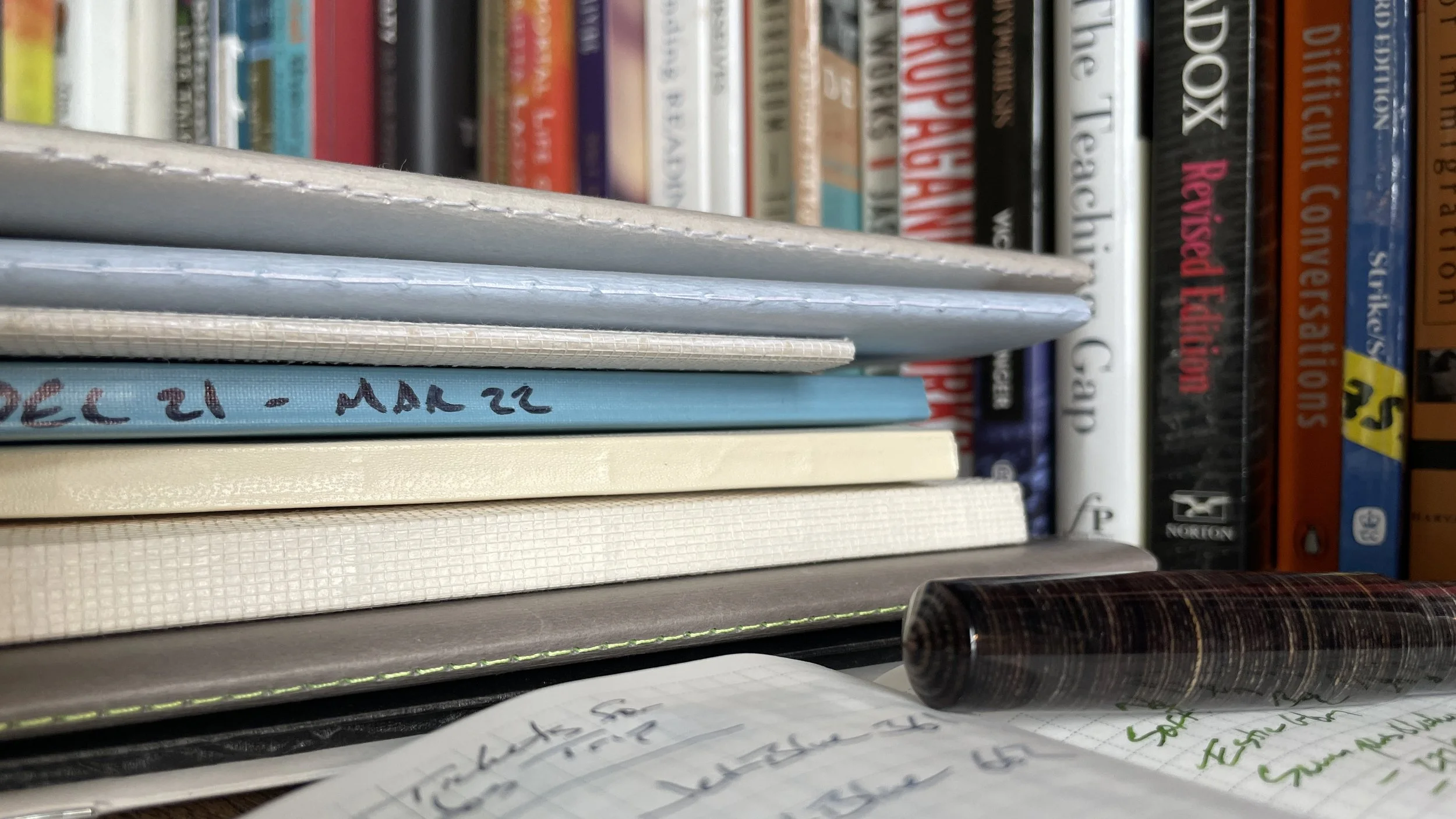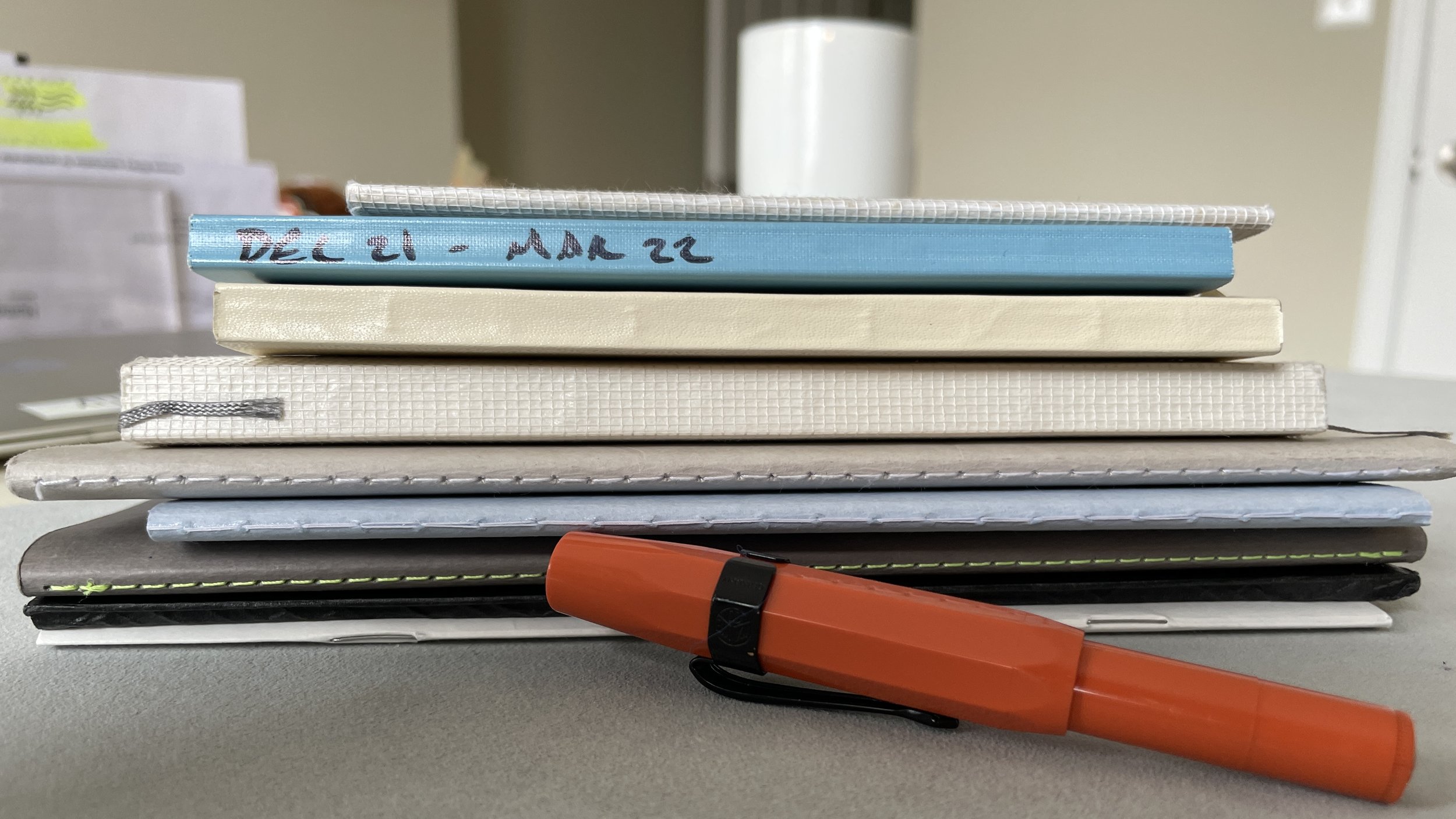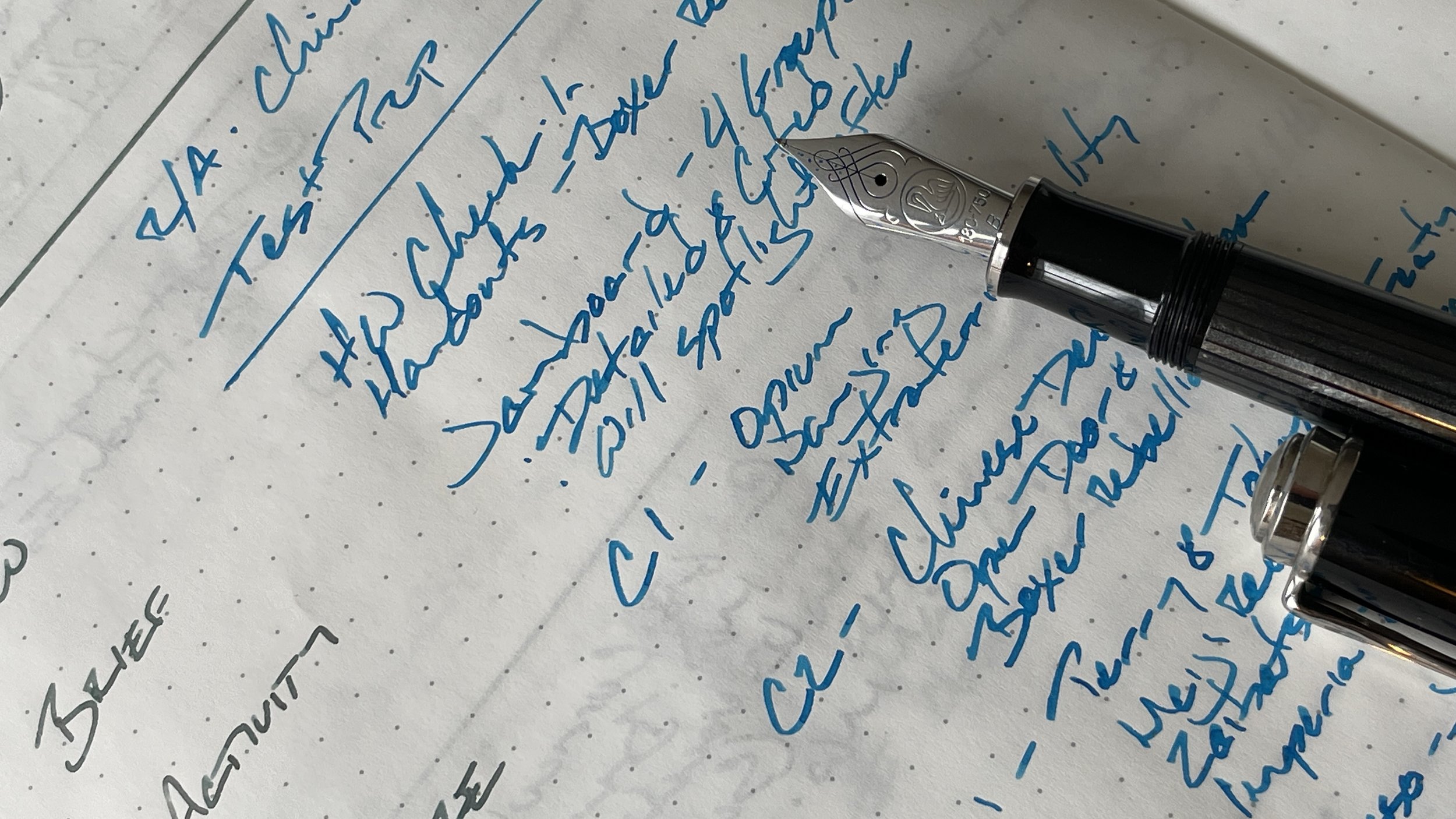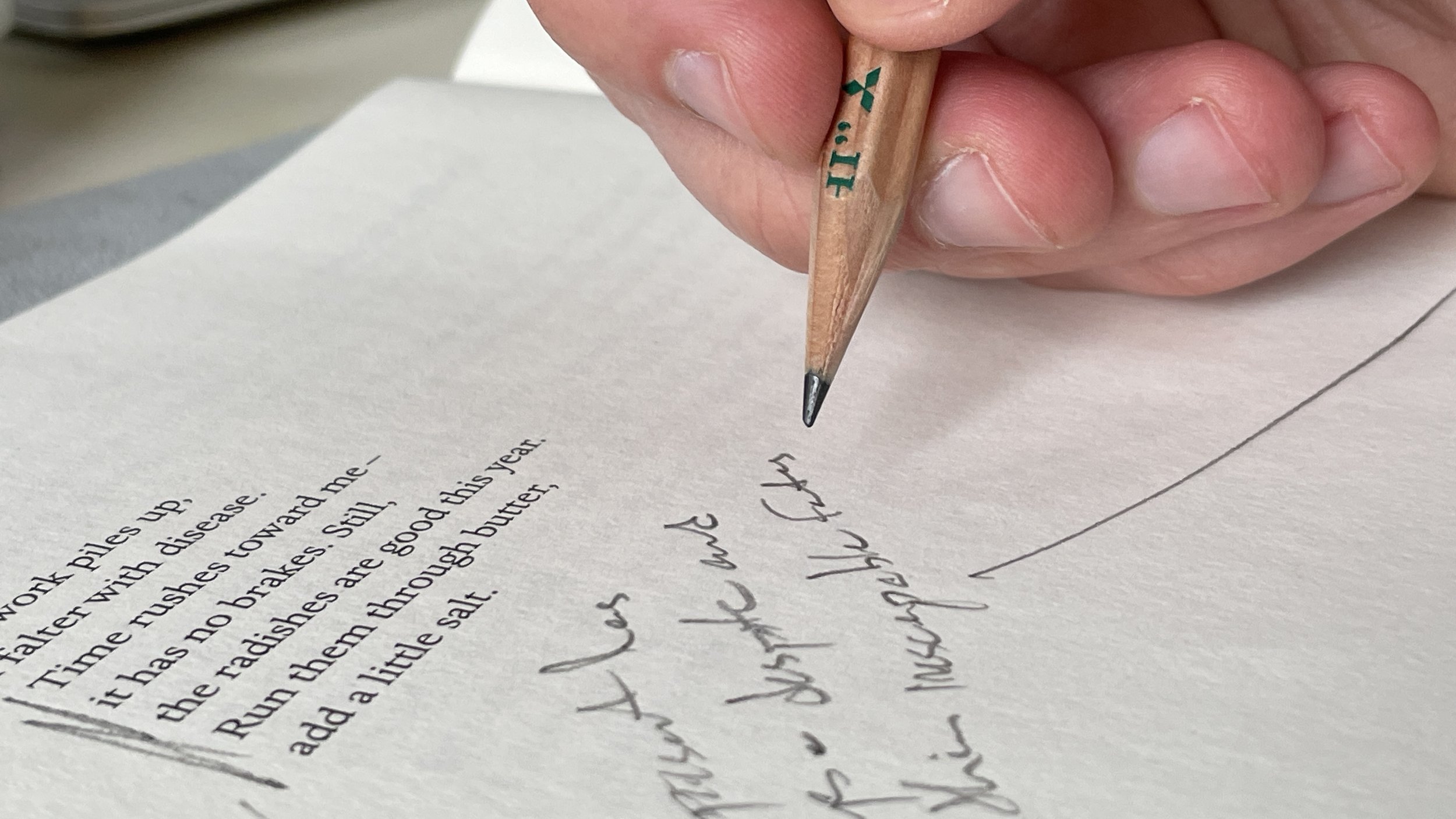Thin softbound notebooks are low-stakes experimentation platforms
I’ve taken warmly to thin softbound notebooks of late — especially for my personal journaling. I just started my third in a row. Softbound notebooks are low stakes platforms for experimentation.
Oh, Kleid. Your minimalist covers get me.
Thread-bound softcovers offer small page counts compared to the 200 or more pages often offered in hardcover notebooks. I need only write my way through 100 pages before I get to transition into a new pad or book. Easy in and quickly out.
Narrow commitment times lead me to make adventurous choices in papers. For instance, my new journal sports OK Fools paper, which I use irregularly. It’s toothy and handles fountain pen inks with character. Shading and sheen show. High class paper with a punk attitude. Paper qualities that will motivate me to lay out my journaling assortment often. At least for a few months. Just the amount of time I’ll need to fill the Kleid with my ramblings.
Thin notebooks encourage me to play with fun rulings for the same reasons. My particular Kleid sports a tiny 2mm grid that is printed in a dusty purple. It’s a blast of fresh air after a calendar year of 5mm grids. I’m forced to think intentionally about line widths, letter size and spacing while I write. Disrupting the unthinking usual of following along in a 5mm grid — which has its perks as well.
Present and out of the way. The backup singer of ruling colors.
Such slim profiles often come with comparatively low price points, too. This Kleid cost us $6.00. A reasonable buy-in for high-performing paper, fun grid, and lovely minimal cover styling. Aesthetics make me want to spend time with a notebook. To sit with it. A feeling RB describes resonantly
Novelty machines.
Small wonder I’m on my third softbound journal in a row.
This week’s Inked Tines update includes last week’s currently inked writing tools.
Toolset
Pens. I am smitten with my Esterbrook Estie Raven and it’s fun hand-engraved M nib. The week’s daily driver. Task management in two personalities: M for tasks themselves and EF reverse writing for tracking progress. Enjoyable writing in both orientations. Meeting notes, lesson plans, and journaling. A standout combo in that I actively sought out reasons to write with this pair. 1/2 remaining.
Able Snail Classic (EF) — 1/5. Titanium tooth and profound shading kept this pairing in my hand. Continues writing reliably. Did need the feed to be flooded after a full B6 page of quickly-written reflections. Journaling, lesson plans, meeting notes, teaching reflections, and creative writing.
Franklin-Christoph 03 (B) — 1/4. A longform writer last week. A one-page journal entry and a curriculum planning meeting alone combine to four pages of writing. Periodic hard starts that easily resolve after a moment of resting the B nib on a page.
Nakaya Neostandard (M Naginata-togi) — 1/3. The Nakaya joined me through two curricular meetings. The clip held securely in my coat pocket while not in use. M lines for longform and quick jottings. EF lines for detailed notes. Booyah. Also: journaling.
Kaweco Sport (EF) — 1/3. I used this pair for a little of everything: scratch notes, creative writing, a teaching reflection, and manuscript marking. Reliable, if toothy, throughout. The tapas of writers.
Mr. Cypress Cone (EF) — 1/2. Infrequently used. Some teaching notes, manuscript marking, and one recorded a short poem across one page of my journal.
Pelikan m805 (F Architect) — 1/2. A teaching observation pushed the boundaries of comfortable quick writing. Spanish Blue is an excellent partner, writing wetly enough to ensure smooth writing and fun shading, even which scrawling furiously in ethnographic shorthand.
Notebooks. Work bujo. Kokuyo Century Grid (A5). A raucous week at week led to thirteen new pages in my work bullet journal, concluding on page 287. A two-page weekly, two lesson plan outlines (each one page), eight pages of meeting notes, and a page of teaching notes. All seven pens met paper at some point in those thirteen pages.
All aboard the education train
I tracked tasks through the first five-day teaching week in a month. The Estie was my go-to for recording tasks. I used my new nib’s EF reverse writing to track the statuses of those tasks.
Petrichor’s dusty silver-grey contrasts against last week’s two most saturated inks: Spanish Blue and Gesztenyebarna. It was easy to parse silver-grey notes on the kinds of activities I had planned from the details on those activities, which I noted in the two accent colors.
Some happy blue for a lesson on imperialism in China and Japan
My meeting notes are a sloppy assortment of scribblings, from planning field trips to curriculum discussions, to scheduling details for a listening tour I want to undertake as I prepare a new elective course for next school year. Varied kinds of notes, all taken with round nib grinds.
The M Naginata-Togi, M Able Snail, and B Jowo all dutifully wrote, even when my writing angle grew unreliable. Writing while talking, listening, and reviewing notes on my laptop is a challenging affair. I appreciate a nib that writes on while my mind and attention juggle.
Easy writing for challenging thought work
Journal. Kleid Notes Tiny Grid (B6). I also journaled my way across the peaks and valleys of eight pages in my new personal journal. Three reflections, one analytic entry, and two poems.
Including one of my own, inked in Rikyu-cha
The B6 notebook size matches my current writing patterns. I've gravitated towards fine lines of late, with EF and F/M nibs dominating my currently inked loadouts. Narrow lines present an economy of letters on each notebook line. The smaller B6 footprint expedites filling pages to about the same pace as M and B line widths in A5 notebooks. Further, the Kleid’s tiny grid is indeed a gnomish 2mm box grid. Excellent housing for my tiny writing. Balancing the scales.
I opted for 6mm triplets for spacing out my writing in the Kleid. One row of padding, a second row for tall letters and capitals, and a third row for most letterforms. I had to consciously count rows throughout my first two entries. But counting tripleted rows grew into second nature by Thursday evening’s journaling session.
Chestnut spacing and shading
All seven pens chipped in. Teamwork.
Written dry. Seven survivors. Seven inked pens entered the week. Seven inked pens remain.
Newly inked. Nopity nope.
The collection
Incoming / new orders. I have behaved. I truly behaved. No new orders last week. A short streak of enjoying what is already in my collection begins. Let the universe sing.
Outgoing / trades or sales. Nada.
Currently reading and listening
Fiction. I finished Zahn’s Heir to the Empire on Wednesday evening. I spent multiple hours unwinding on weekday evenings, engrossed in the final conflicts of the Republic’s growing pains and the nascent Empire’s resurgence; 84 pages in all.
Apple’s Books app continues to be a reliable medium for my fiction reading.
Except for poetry. I returned to Jim Harrison’s poetry Thursday and Friday nights. Scribbling in the margins with a pencil is now habit.
Just me, Harrison and Mitsubishi
Nonfiction. I leaned on already-prepared readings from the past three weeks for use in my classes. As such, my time was spent reviewing already-marked book chapters instead of digging into new nonfiction. Annotations doing their work.
Music. Most of my free time last week was spent engrossed in science-fiction adventuring and reflective journaling. Both activities can accommodate an energetic soundtrack — or, more specifically, music with vocals.
Seafret accompanied my reading and writing Monday through Thursday evening. Love songs that blend Hozier-esque arrangements with a Coldplay-like vocal delivery. Present but politely so. Gruff with a wink.












